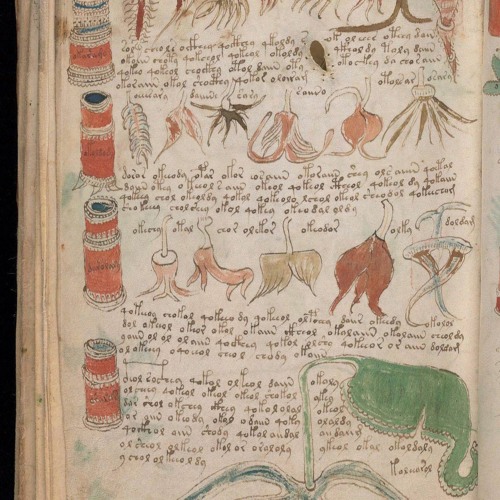
“A lot of languages were proposed, such as Latin, Czech, or amongst others Nahuatl (spoken by the Aztecs), just to name a few. “Countless decipherment attempts were made,” Hannig writes in an article in German explaining his methodology.
#VOYNICH MANUSCRIPT ART CRACKED#
Now, after three years of analysis, the German Egyptologist Rainer Hannig from the Roemer -und Pelizaeus Museum in Hildesheim, believes he has cracked the code to translating the work, and found the manuscript's language to be based on Hebrew.
#VOYNICH MANUSCRIPT ART TV#
Because of the many mysteries surrounding its content, it has featured in TV shows, books, music, and even video games. That medievalists can and should bring their expertise to bear on the manuscript.Will the Voynich Manuscript, an early 15th century document kept at Yale University and known as the world’s most mysterious book, finally reveal its secrets?Īny attempts to decipher the manuscript's unique text, made up of a mixture of handwritten Latin letters, Arabic numbers, and unknown characters, have so far failed. That the manuscript's intellectual climate is observable in its illustrations and 2. Even if this hypothesis proves incorrect, I make two broader claims: 1. In my opinion, Hartlieb is the most viable candidate proposed thus far for the text's author. Hartlieb wrote on all these matters, lived at the right time and place, and is on record as having suggested the use of ciphers to hide sensitive women's matters. 1410-1468) as a candidate for authorship. The many odd illustrations of plants, nude European-looking women, baths, tubes, and stars, among other things, place the text's intellectual climate firmly in a variety of entangled late-medieval European sciences, including astrology, balneology, herbology, and gynaecology. This is despite the fact that carbon dating has placed the fascinating manuscript firmly in the 15th century. The enciphered Voynich Manuscript has captured the public imagination but rarely been the subject of study by medievalists. From the Clares, I am able to trace the manuscript into the English royal collection of Edward I and II, connect it with the previously known provenance of ownership by John Duke of Bedford, and back into a heretofore unknown ownership of William Cleve, rector of Cliff at Hoo. My evidence for earlier provenance draws on the scribe's use of the Clare's arms, three red chevrons, as the first signe-de-renvoi, a symbol to guide the reader. Previously, scholarship traced the 1250s Paris Apocalypse only to the 1370s in Charles V's collection. 403) was originally owned by the Clare Family, in particular Richard de Clare (5th Earl of Hertford, 6th Earl of Gloucester) and his wife Maud. This paper presents new evidence that the Paris Apocalypse (Paris, BnF, MS fr. It also addresses possible templates, that may have had influenced, directly or indirectly the production of the Hamburg manuscript. This paper investigates the cultural climate, in which the manuscript was produced. Readjusting illustrative program and system of visual organisation of the contemporary English cycles along with ones of the older templates, as well as integrating an uncommon for this period Latin commentary of Gilbertus, the designer of the Hamburg Apocalypse had created a completely unique cycle. However, the principles of the organisation of English manuscripts here have been greatly transformed, which offers a complete new system of visual organisation and interplay of the text with illustrations. Although the illustrations of the manuscript are clearly made in German style, the compositions and the selection of some scenes probably refer, among others, to English templates.

Hamburg Apocalypse belongs to a small group of German Apocalypses within which it has a unique status. The manuscript contains text of the Revelation of John with a prologue by Gilbertus Porretanus and it is vividly illustrated. The Hamburg Apocalypse (Staats- und Universitätsbibliothek Hamburg, Carl von Ossietzky, Codex In Scrinio 87) is a manuscript from the first quarter of the 14th century and was most likely executed in the monastery of St Peter and Paul in Erfurt. Keagan Joel Brewer, Department of English, Macquarie University The Voynich Manuscript's Intellectual Climate and Authorship 1250-1470Įmerson Richards-Hoppe, Department of Comparative Literature, Indiana University

'Ici faut glose et tixt et premier fuill suivant a tieu signe la troverez': New Suggestions about Early Ownership of the Paris Apocalypse (Bibliothèque nationale de France, MS Fr. Polina Yaroslavtseva, Exzellenzcluster 'Understanding Written Artefacts', Universität Hamburg Katherine Rush, Department of the History of Art, University of California, RiversideĬlimate of Change: The Case of Production of the Hamburg Apocalypse (Staats- und Universitätsbibliothek Hamburg, Carl von Ossietzky, Codex In Scrinio 87) Manuscript Production in England, France, and Central Europe: Patrons, Collections, Artists, and Context


 0 kommentar(er)
0 kommentar(er)
